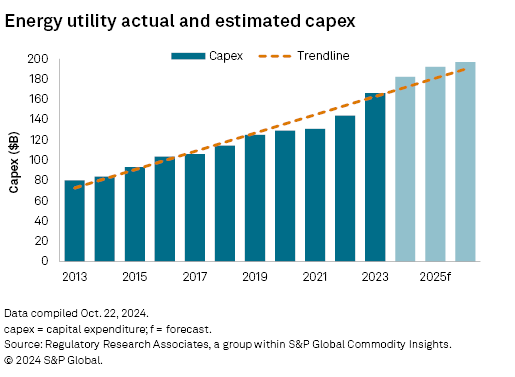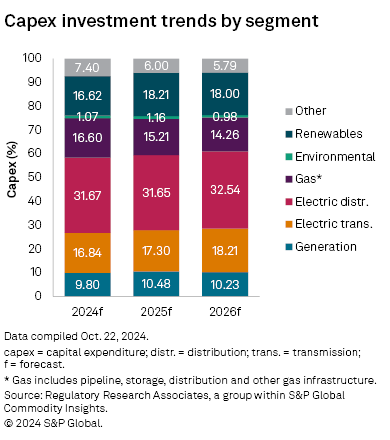Featured Topics
Featured Products
Events
S&P Global Offerings
Featured Topics
Featured Products
Events
S&P Global Offerings
Featured Topics
Featured Products
Events
S&P Global Offerings
Featured Topics
Featured Products
Events
Financial and Market intelligence
Fundamental & Alternative Datasets
Government & Defense
Banking & Capital Markets
Economy & Finance
Energy Transition & Sustainability
Technology & Innovation
Podcasts & Newsletters
Financial and Market intelligence
Fundamental & Alternative Datasets
Government & Defense
Banking & Capital Markets
Economy & Finance
Energy Transition & Sustainability
Technology & Innovation
Podcasts & Newsletters
Research — Nov 14, 2024
The nation's electric, gas and water utilities are investing in infrastructure to upgrade aging transmission and distribution systems, build new natural gas, solar and wind generation, and implement new technologies, including smart meter deployment, smart grid systems, cybersecurity measures, electric vehicles and battery storage. These considerable levels of spending are expected to serve as the basis for solid profit expansion in the utility industry for the foreseeable future.
Multiple drivers are expected to elevate utility capital expenditures over the next several years. Pent-up demand to replace aging equipment is already propelling considerable utility investments in infrastructure. Meanwhile, state renewable portfolio standards continue to ramp up, necessitating large expansions of low-carbon energy generation capacity. Amplifying these factors are federal infrastructure investment plans, including the Inflation Reduction Act of 2022, which aims to convert the US power generation network to a majority of zero-carbon sources by 2035.
|
|
Utility Capital Expenditures H2'24 report |
➤ Projected 2024 capital expenditures for the 45 energy utilities included in the Regulatory Research Associates representative sample of publicly traded, US-based utilities are over $182 billion — a 9.5% leap from the group's $166 billion of actual spending in 2023 and 26% above the $144 billion of actual investment in 2022.
➤ Across the small investor-owned water utility industry, total capex is forecast to increase by nearly 14% in 2024 to $5.5 billion from $4.8 billion in 2023. This follows growth surges in 2023 and 2022 of 13.6% and 18%, respectively.
➤ Forecast aggregate utility investments in 2025, 2026 and 2027 are expected to reach new records of $192 billion, $196.5 and $197 billion, respectively. The increases are being driven in large part by federal legislation enacted in 2021 and 2022 supporting infrastructure investment, state-level energy transition plans and incentives, as well as robust growth in demand from datacenters as the explosion in implementation of artificial intelligence and cloud computing continues.
➤ Forecasts for capex in the 2025–27 period are likely to be revised upward as companies' plans for future projects gel and the uncertainty around the US elections cycle passes.
Energy utilities expected to invest in renewables at increasing levels in 2025 and 2026
Despite the looming threat US elections pose to energy transition investments supported by the IRA, the structures underlying the law's financial support are expected to generally weather a change in administration. Many of the IRA subsidies are structured as tax credits, which function essentially as tax cuts, at least partially ringfencing these provisions from a change in control of Congress or the White House.
|
Planned infrastructure investment initiatives for US electric and gas utilities include: updating aging transmission and distribution systems; building new natural gas, solar and wind generation; and the implementation of new technologies, such as smart meter deployment, smart grid systems, cybersecurity measures and battery storage. Considerable levels of spending are expected to serve as the basis for solid profit expansion in the sector for the foreseeable future.
Investment in renewables within RRA's coverage landscape is projected to reach $25 billion in 2024 and to continue growing next year and the year after, with the annual investment total rising above $29.5 billion in both 2025 and 2026. A number of factors will provide the impetus for ongoing electric utility renewable energy development, including falling technology costs, state policy and renewable portfolio standards, customer demand, and environmental, social and governance considerations, amid a broader trend toward utility sector decarbonization.
The proliferation of renewable generation resources, which are often great distances from load centers, will continue to drive new transmission line projects. Additionally, despite challenges to the rate of return levels authorized by the Federal Energy Regulatory Commission, such as from periodic shifts in return on equity calculation methodologies and underlying models, the average return on equity allowed on transmission investments remains above the average equity return authorized by state commissions in traditional general base rate case proceedings.
|
From a natural gas perspective, capex will continue to be driven by replacement of mature gas distribution infrastructure for many years, considering state and federal mandates to address safety. Despite headwinds in many regions of the country, gas is expected to remain a critical energy source for some time, especially with the need to fill capacity gaps created by increasing datacenter demand that cannot presently be entirely met by renewables, absent sufficient and widespread energy storage. In addition, midstream pipelines and downstream distribution networks are likely to be central to efforts by many midstream and utility enterprises to extend the life of their infrastructure through transportation of renewable natural gas and hydrogen blends.
Refer to the linked report and associated data tables for additional insight into infrastructure investments over the next several years within the US utility industry, including intelligence distilled from the aggregation of multiple individual company forecasts.
Note: This report is designed to identify capital expenditure trends in the US utility sector, drawing data from a range of sources, including corporate investor presentations, annual reports and other sources. While S&P Global Market Intelligence strives to ensure the accuracy of the included underlying data, the sources vary in terms of depth, quality and timeliness. Actual company-specific capital expenditure information should be acquired from filings with the US Securities and Exchange Commission.
S&P Global Commodity Insights produces content for distribution on S&P Capital IQ.
Regulatory Research Associates is a group within S&P Global Commodity Insights.
For a full listing of past and pending rate cases, rate case statistics and upcoming events, visit the S&P Capital IQ Pro Energy Research Home Page.
For a complete, searchable listing of RRA's in-depth research and analysis, please go to the S&P Capital IQ Pro Energy Research Library.
Theme
Location


